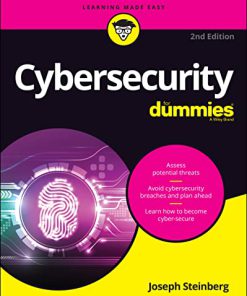Cybersecurity for Dummies 1st editon by Joseph Steinberg 1119867207 9781119867203
$50.00 Original price was: $50.00.$25.00Current price is: $25.00.
Cybersecurity for Dummies 1st editon by Joseph Steinberg – Ebook PDF Instant Download/Delivery: 1119867207, 9781119867203
Full download Cybersecurity for Dummies 1st editon after payment
Product details:
ISBN 10: 1119867207
ISBN 13: 9781119867203
Author: Joseph Steinberg
PRIMARY AUDIENCE: Those interested in going into the field of cybersecurity, as well as people who want to be cyber-secure in their homes or small businesses.
Cybersecurity for Dummies 1st Table of contents:
Part 1: Getting Started with Cybersecurity
Chapter 1: What Exactly Is Cybersecurity?
Cybersecurity Means Different Things to Different Folks
Cybersecurity Is a Constantly Moving Target
Looking at the Risks Cybersecurity Mitigates
Chapter 2: Getting to Know Common Cyberattacks
Attacks That Inflict Damage
Is That Really You? Impersonation
Messing around with Other People’s Stuff: Tampering
Captured in Transit: Interception
Taking What Isn’t Theirs: Data Theft
Cyberbombs That Sneak into Your Devices: Malware
Poisoned Web Service Attacks
Network Infrastructure Poisoning
Malvertising
Exploiting Maintenance Difficulties
Advanced Attacks
Some Technical Attack Techniques
Chapter 3: The Bad Guys You Must Defend Against
Bad Guys and Good Guys Are Relative Terms
Bad Guys Up to No Good
Cyberattackers and Their Colored Hats
How Cybercriminals Monetize Their Actions
Not All Dangers Come From Attackers: Dealing with Nonmalicious Threats
Defending against These Attackers
Part 2: Improving Your Own Personal Security
Chapter 4: Evaluating Your Current Cybersecurity Posture
Don’t be Achilles: Identifying Ways You May Be Less than Secure
Identifying Risks
Protecting against Risks
Evaluating Your Current Security Measures
Privacy 101
Banking Online Safely
Safely Using Smart Devices
Cryptocurrency Security 101
Chapter 5: Enhancing Physical Security
Understanding Why Physical Security Matters
Taking Inventory
Locating Your Vulnerable Data
Creating and Executing a Physical Security Plan
Implementing Physical Security
Security for Mobile Devices
Realizing That Insiders Pose the Greatest Risks
Chapter 6: Cybersecurity Considerations When Working from Home
Network Security Concerns
Device Security Concerns
Location Cybersecurity
Video Conferencing Cybersecurity
Social Engineering Issues
Regulatory Issues
Part 3: Protecting Yourself from Yourself
Chapter 7: Securing Your Accounts
Realizing You’re a Target
Securing Your External Accounts
Securing Data Associated with User Accounts
Securing Data with Parties You’ve Interacted With
Securing Data at Parties You Haven’t Interacted With
Securing Data by Not Connecting Hardware with Unknown Pedigrees
Chapter 8: Passwords
Passwords: The Primary Form of Authentication
Avoiding Simplistic Passwords
Password Considerations
Creating Memorable, Strong Passwords
Knowing When to Change Passwords
Changing Passwords after a Breach
Providing Passwords to Humans
Storing Passwords
Transmitting Passwords
Discovering Alternatives to Passwords
Chapter 9: Preventing Social Engineering Attacks
Don’t Trust Technology More than You Would People
Types of Social Engineering Attacks
Six Principles Social Engineers Exploit
Don’t Overshare on Social Media
Leaking Data by Sharing Information as Part of Viral Trends
Identifying Fake Social Media Connections
Using Bogus Information
Using Security Software
General Cyberhygiene Can Help Prevent Social Engineering
Part 4: Cybersecurity for Businesses, Organizations, and Government
Chapter 10: Securing Your Small Business
Making Sure Someone Is In Charge
Watching Out for Employees
Dealing with a Remote Workforce
Considering Cybersecurity Insurance
Complying with Regulations and Compliance
Handling Internet Access
Managing Power Issues
Chapter 11: Cybersecurity and Big Businesses
Utilizing Technological Complexity
Managing Custom Systems
Continuity Planning and Disaster Recovery
Looking at Regulations
Deeper Pockets — and Insured
Considering Employees, Consultants, and Partners
Looking at the Chief Information Security Officer’s Role
Part 5: Handling a Security Incident (This Is a When, Not an If)
Chapter 12: Identifying a Security Breach
Identifying Overt Breaches
Detecting Covert Breaches
Chapter 13: Recovering from a Security Breach
An Ounce of Prevention Is Worth Many Tons of Response
Stay Calm and Act Now with Wisdom
Bring in a Pro
Recovering from a Breach without a Pro’s Help
Reinstall Damaged Software
Dealing with Stolen Information
Recovering When Your Data Is Compromised at a Third Party
Part 6: Backing Up and Recovery
Chapter 14: Backing Up
Backing Up Is a Must
Backing Up Data from Apps and Online Accounts
Backing Up Data on Smartphones
Conducting Cryptocurrency Backups
Backing Up Passwords
Looking at the Different Types of Backups
Figuring Out How Often You Should Backup
Exploring Backup Tools
Creating a Boot Disk
Knowing Where to Back Up
Knowing Where Not to Store Backups
Encrypting Backups
Testing Backups
Disposing of Backups
Chapter 15: Resetting Your Device
Exploring Two Types of Resets
Rebuilding Your Device after a Hard Reset
Chapter 16: Restoring from Backups
You Will Need to Restore
Wait! Do Not Restore Yet!
Restoring Data to Apps
Restoring from Full Backups of Systems
Restoring from Incremental Backups
Dealing with Deletions
Excluding Files and Folders
Understanding Archives
Restoring Using Backup Tools
Returning Backups to Their Proper Locations
Restoring to Non-Original Locations
Never Leave Your Backups Connected
Restoring from Encrypted Backups
Testing Backups
Restoring Cryptocurrency
Booting from a Boot Disk
Part 7: Looking toward the Future
Chapter 17: Pursuing a Cybersecurity Career
Professional Roles in Cybersecurity
Exploring Career Paths
Starting Out in Information Security
Exploring Popular Certifications
Overcoming a Criminal Record
Overcoming Bad Credit
Looking at Other Professions with a Cybersecurity Focus
Chapter 18: Emerging Technologies Bring New Threats
Relying on the Internet of Things
Using Cryptocurrencies and Blockchain
Cloud-Based Applications and Data
Optimizing Artificial Intelligence
Where Was This Laptop Really Made? Supply Chain Risks
Nothing Is Trustworthy: Zero Trust
Genius Computers Are Coming: Quantum Supremacy
Experiencing Virtual Reality
Transforming Experiences with Augmented Reality
Part 8: The Part of Tens
Chapter 19: Ten Ways to Improve Your Cybersecurity without Spending a Fortune
Understand That You Are a Target
Use Security Software
Encrypt Sensitive Information
Back Up Often
Do Not Share Login Credentials
Use Proper Authentication
Use Social Media Wisely
Segregate Internet Access
Use Public Wi-Fi Safely (Or Better Yet, Don’t Use It!)
Hire a Pro
Chapter 20: Ten (or So) Lessons from Major Cybersecurity Breaches
Marriott
Target
Sony Pictures
U.S. Office of Personnel Management
Anthem
Colonial Pipeline and JBS SA
Chapter 21: Ten Ways to Safely Use Public Wi-Fi
Use Your Cellphone as a Mobile Hotspot
Turn Off Wi-Fi Connectivity When You’re Not Using Wi-Fi
Don’t Perform Sensitive Tasks over Public Wi-Fi
Don’t Reset Passwords When Using Public Wi-Fi
Use a VPN Service
Use Tor
Use Encryption
Turn Off Sharing
Have Information Security Software on Any Devices Connected to Public Wi-Fi Networks
Understand the Difference between True Public Wi-Fi and Shared Wi-Fi
Index
About the Author
Advertisement Page
Connect with Dummies
End User License Agreement
People also search for Cybersecurity for Dummies 1st :
basic cyber security terms
what to learn first for cyber security
starting out in cyber security
what is cyber security for beginners
Tags:
Joseph Steinberg,Cybersecurity,Dummies
You may also like…
Computers - Security
Computers - Security
Computers - Security
Animals & Pets - Animal Care & Pets
Psychology - Developmental Psychology
Computers - Security
Politics & Philosophy - Government & Politics
Biology and other natural sciences - Biology
Psychology - Developmental Psychology












